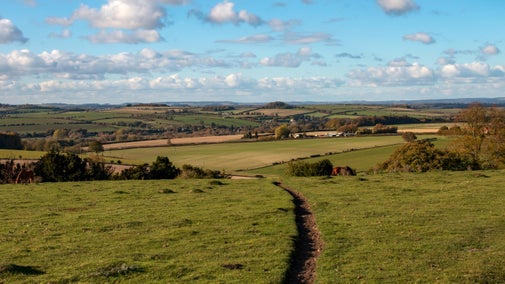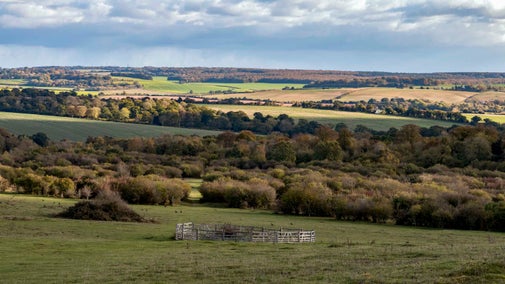
Donate
Everyone needs nature, now more than ever. Donate today and you could help people and nature to thrive at the places we care for.

The habitat diversity of Stockbridge Down, Stockbridge Marsh and Curbridge Nature Reserve is hugely beneficial to local wildlife including rare species. We manage and care for these sites in a variety of ways including regular programmes of conservation grazing and riverbank restoration, as well as special projects such as new woodland creation.
Cattle graze the main part of the Down as part of common rights, helping to keep the scrub regrowth in check. This ensures the Down hosts an array of grasses and wildflowers that many invertebrate species can benefit from. And thanks to this grazing regime and other careful land management, Stockbridge Down hosts an absolute spectacle of wildflowers during the spring and summer months.
Some commoners take up their common rights here in the form of grazing – the Marsh is grazed by cattle and horses during the summer. These animals help to keep the dominant grasses down and allow a wider diversity of flora species to thrive.
As well as grazing, our team manage the control of species such as ragwort and creeping thistle, both of which can become dominant, and the growth of hawthorn scrub on the site.

Stockbridge Marsh is a SSSI which is subject to a lot of pressure from recreational activities. We’ve fenced off some areas along the riverside, to allow the bank and its vegetation to recover from high footfall.
Sadly, Natural England have acknowledged that the site can no longer provide habitat for ground-nesting birds due to the number of dogs which run free here. And the high footfall has a detrimental effect to the ground itself: as well as eroding the surface of the bank, this pressure destroys the bankside vegetation, which in turn increases the problem of erosion, as vegetation acts as a buffer against the water flow.
We’ve carried out these remedial measures in the recent past, with positive results: vegetation bloomed back again in fenced off locations within a couple of years and water voles returned to a previously abandoned area.
The Marsh is still a place where people are welcome to bring their dogs and enjoy a picnic. There are two points where grazing stock, people and dogs can directly access the water: at the northern end of the marsh by the path that comes in from Stockbridge town, and at the ford two thirds of the way down the stream. Using these access points means that the other areas will have a chance to recover.
There are also footpaths near to the water’s edge where people can still enjoy the sights and sounds of the river and the surrounding wildlife.
The popularity of Curbridge Nature Reserve has led to heavy recreational pressure. The fragile site is surrounded by urban development and bankside trees are being lost to the natural tidal influences of the river. We're creating a new woodland to help protect this important site. Find out how we're helping Curbridge Nature Reserve to survive and thrive.
Aside from this major project, the reserve generally has minimal intervention in terms of management, in order to keep the tranquillity of the ancient woodland setting. However, we do carry out coppicing, tree survey/emergency works and litter picking.

Everyone needs nature, now more than ever. Donate today and you could help people and nature to thrive at the places we care for.

Our work managing Mottisfont’s river and woodlands aims to create a wildlife-rich habitat, find out more about how we care for the estate.

A chalk hill supporting grassland, areas of scrub and partially wooded margins, the habitat diversity of Stockbridge Down is hugely beneficial to local wildlife.

A Site of Special Scientific Interest in the peaty river valley of the River Test. A rich wetland habitat, the Marsh consists of unimproved wet grassland and fen-like vegetation.

Explore Curbridge Nature Reserve on the River Hamble, an ancient riverside woodland important for wild birds, waterfowl, salt marsh and rare invertebrates.

Find out how you could join us - whether you're looking to make new friends, develop skills or simply want to be part of something you're passionate about.

From activity trails in the garden to playing pooh sticks on the bridge, there's something for every young explorer to do at Mottisfont.

We believe that nature, beauty and history are for everyone. That’s why we’re supporting wildlife, protecting historic sites and more. Find out about our work.

Read about our strategy 'For everyone, for ever' here at the National Trust, which will take the organisation through to 2025.